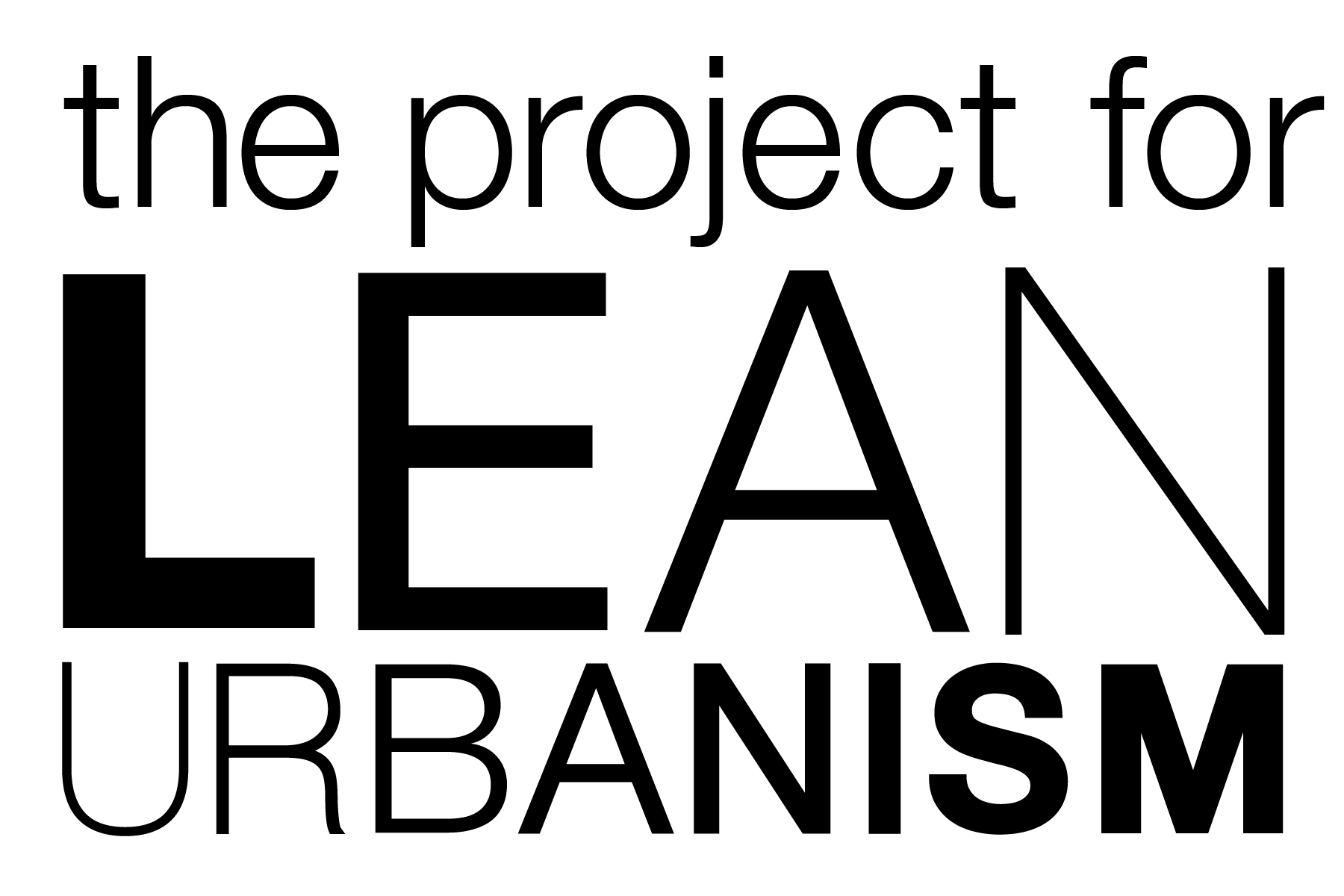Tenets and Principles
The Project for Lean Urbanism is an open-access, open-source initiative to devise means and methods so that community-building becomes more locally initiated, takes less time, reduces the resources required for compliance, and frustrates fewer well-intentioned entrepreneurs, by providing ways to work around onerous financial, bureaucratic, and regulatory processes.
For Lean Urbanism to become an effective tool in its proper Lean Seam, it is a useful exercise to examine its tenets in relation to a standard for good urbanism. Testing the tenets of Lean Urbanism against the broadly accepted urban principles of the Charter of the New Urbanism may be said to have the same virtue for responsible, practicing urbanists that the Hippocratic Oath holds for medical professionals. In making regulation more streamlined while preserving public health and safety; in opening development opportunities to more local citizens and at differing scales; in facilitating right-sized, durable infrastructure; in encouraging entrepreneurship and learning among the citizenry; and doing all of this in an ethical and sustainable manner, the goal of The Project for Lean Urbanism is to create a more democratic, streamlined, diverse and livable urban regulatory and physical environment.
The Comparison
Because the Charter and the Lean tenets slice through the subject matter at different biases, categories of congruity between the two are established as follows:
- Lean
- Lean with caveat
- Outside the Lean Seam
Unsurprisingly, a number of the characteristics of Lean Urbanism comport well with Charter Principles. Nonetheless, more than half of the Charter Principles fall entirely outside of the Lean Seam. Only 9 of the 27 Charter principles fall wholly within the Lean Seam. This distinction between the tenets of Lean Urbanism and the Charter of the New Urbanism more often than not is attributable to the fact that control over the subject area of a principle occurs at a higher level of decision-making than is within the Lean Seam. Other Charter principles are inapplicable due to their scale being too large for Lean action or too unwieldy to be implemented in a Lean manner. What follows is a brief assessment of how well and in what ways the tenets of Lean Uurbanism conform with the principles of the Charter of the New Urbanism. For the sake of brevity, the principles that comport with Lean are included below with the addition of one principle each “outside the lean seam” and “lean to the extent that…” An assessment of all 27 principles will be made available upon request.
The Region: Metropolis, City, and Town
1. Metropolitan regions are finite places with geographic boundaries derived from topography, watersheds, coastlines, farmlands, regional parks, and river basins. The metropolis is made of multiple centers that are cities, towns, and villages, each with its own identifiable center and edges.
Lean with caveat: The recognition of “boundedness” as essential to Lean metropolitanism allows Lean action and feedback on initiatives. It engages individuals and identifies “constituencies most affected” in their “home place(s)” even as it nests them within their broader region. One of the key tenets of Lean Urbanism is subsidiarity: that decision-making should reside at the lowest level of control or management that is appropriate and competent.
2. The metropolitan region is a fundamental economic unit of the contemporary world. Governmental cooperation, public policy, physical planning, and economic strategies must reflect this new reality.
Outside the Lean Seam: Regional economic health is related to issues of competition with entities outside of the region (New York vs Shanghai; Minneapolis vs Jaipur; Houston vs Riyadh). To the extent that this requires policy and governance structures that have an external orientation, this principle is not within the Lean Seam.
4. Development patterns should not blur or eradicate the edges of the metropolis. Infill development within existing urban areas conserves environmental resources, economic investment, and social fabric, while reclaiming marginal and abandoned areas. Metropolitan regions should develop strategies to encourage such infill development over peripheral expansion.
Lean: Infill is the natural habitat for Lean and for urban pioneering that makes the neighborhood safe for trailing residents with less tolerance for risk. This principle explicitly calls for government to facilitate Leaner regulation regimes and for citizens who naturally embrace a Lean sensibility to seek opportunities for Lean action.
6. The development and redevelopment of towns and cities should respect historical patterns, precedents, and boundaries.
Lean: Smaller projects can easily do this; historically (before large lot assemblages) cities developed in smaller increments on smaller tracts, and the Charter encourages this mode of development. Furthermore, redevelopment opportunities within existing neighborhood fabric is a natural niche for Lean action.
The Neighborhood, The District, and The Corridor
10. The neighborhood, the district, and the corridor are the essential elements of development and redevelopment in the metropolis. They form identifiable areas that encourage citizens to take responsibility for their maintenance and evolution.
Lean: Two important principles in the application of Lean Urbanism in relationship to local engagement of “constituencies most affected” are embedded here: “ownership” of place and capacity to control one’s environment. Lean Urbanism encourages citizens to take responsibility for their neighborhood and provides the tools to do so.
The block, the street, and the building
20. Individual architectural projects should be seamlessly linked to their surroundings. This issue transcends style.
Lean: Because Lean projects are initiated by (civic-minded) private citizens, Lean tenets apply directly to this private project scale.
21. The revitalization of urban places depends on safety and security. The design of streets and buildings should reinforce safe environments, but not at the expense of accessibility and openness.
Lean: Practice principles are congruent with this principle, reduce need for high levels of police presence, encourage neighborhood civility, etc.
23. Streets and squares should be safe, comfortable, and interesting to the pedestrian. Properly configured, they encourage walking and enable neighbors to know each other and protect their communities.
Lean: Public spaces as described above are “owned” by the citizens who frequent them. They become shared “living rooms” which facilitate Lean living at home. Parisian café society was a direct result of dwelling units in Paris that were too small to allow private entertaining. Modest accommodations at home create a new and vital social condition within the public realm that contains many of the elements of a Lean ethos.
24. Architecture and landscape design should grow from local climate, topography, history, and building practice.
Lean: This principle encourages thoughtful Lean practice appropriate to place that facilitates Lean use of resources as it builds or restores character of place.
26. All buildings should provide their inhabitants with a clear sense of location, weather and time. Natural methods of heating and cooling can be more resource-efficient than mechanical systems.
Lean:
- This falls within the realm of private development and, thus, the Lean practitioner can exercise full control.
- Reinforcing the relationship between indoors and outdoors is intrinsically Lean. Natural methods may provide adequate environmental conditioning in lieu of expensive mechanical/electrical systems and where renewable energy systems may be efficiently employed.
27. Preservation and renewal of historic buildings, districts, and landscapes affirm the continuity and evolution of urban society.
Lean: This principle is Lean on its face, and in particular by virtue of its re-use of embodied energy (existing historic structures). Its geography is the geography of Lean interventions.
The Charter of the New Urbanism was originally intended to be implemented through coding and formal regulations. Lean Urbanism is effected through informal, sub rosa actions and workarounds of existing governmental regulations and protocols.
The overlap between The Charter of the New Urbanism and the tenets of Lean Urbanism occurs in the Lean Seam, where the scale is small, geography is familiar and local, and methods and technologies are practical and spare. Lean Urbanism responds appropriately to local conditions on the ground in spite of regulations.
Because it exists outside of governmental regulations, Lean action must be ethical action. It must exceed thresholds of adequacy for issues of health, safety and welfare. Lean action may work best where there is an acknowledgement and interdependence between the individual and community norms. Lean action will become more robust and will develop acceptance and self-policing as a culture of Lean Urbanism develops locally.
The exercise of comparing the Charter of the New Urbanism with the Tenets of Lean Urbanism begs a second question: Are there tenets of Lean Urbanism not present in the Charter of the New Urbanism that ought to be incorporated into the Charter?
B. Aaron Parker has practiced architecture and urban design nationally from both Minneapolis and New York, and serves as Adjunct Professor in the College of Architecture and Landscape Architecture at the University of Minnesota, where he has taught architecture and urban design. His academic research has allowed him to develop techniques he then applies in his urban design practice.

